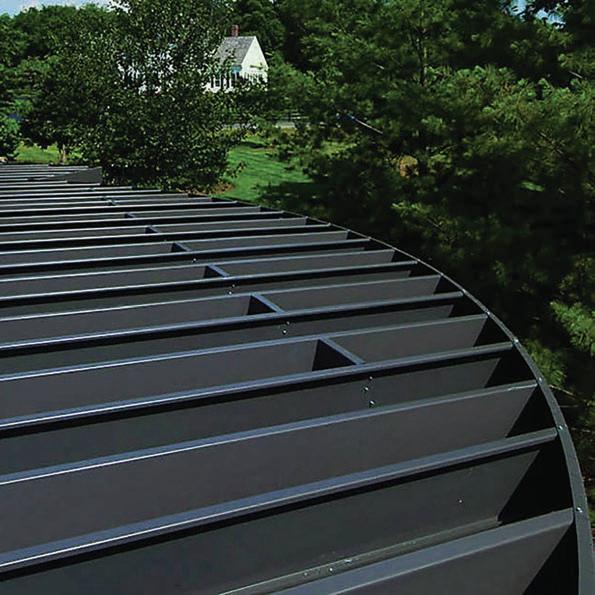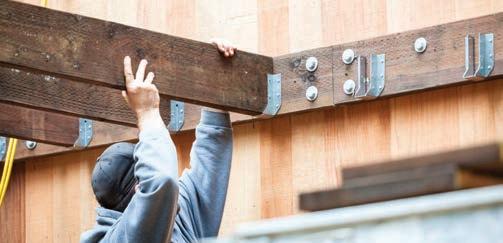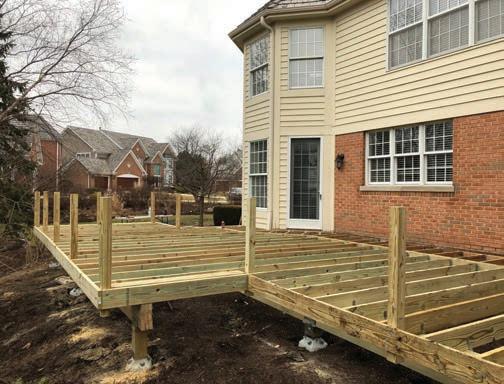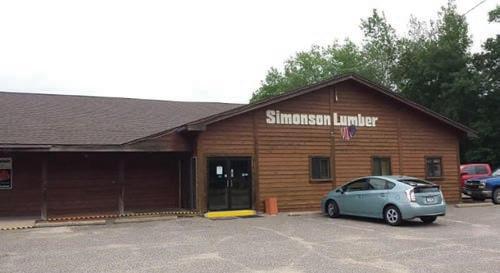
6 minute read
FEATURE STORY
TREX has discontinued its revolutionary Elevations steel deck framing system.
Steel hits wall of treated wood trying to break into deck framing market
Not 18 months ago, residential steel deck framing was being heralded as a serious threat to treated wood for deck framing. Backed by two giant composite deck manufacturers, the systems claimed to have myriad advantages over wood, including improved aesthetics and straighter, uniform pieces with no crowning, warping or twisting.
Yet at the end of last year, market leader Trex abruptly discontinued its Elevations steel deck framing, leaving Fortress Building Products’ Evolution as the last system standing. Trex explained to dealers that the move was part of its normal annual culling of less profitable colors, sizes and products to make room for new products and colors and sizes.
Yet the end of Elevations is a great deal more than the loss of a fifth shade of brown; it’s the elimination of an entire product category, one with great promise, a number of satisfied users, and a much larger number who never gave the pricier product a chance.
Trex expanded into steel deck framing in 2011 with its acquisition of tiny niche player Iron Deck Corp., Denver, Co. The product was terrific; it seemingly just needed the vast distribution network and promotional might of a national powerhouse like Trex. Yet builders still needed to be persuaded to use it and, just as importantly, dealers and even Trex’s own sales force needed to sell it.
“They hated it,” noted one dealer. “Sales would not learn about the product, and it was hard to get support for it.

Decking, decking, decking—that’s all they’re interested in selling.”
PMC Building Materials, Lawrenceville, Ga., not only sold the system—it kept it in stock, and had multiple large deck builders that regularly used it for high-end installs. “I have two customers in particular who are really behind it. They think it’s outstanding. It took our staff educating ourselves about the product and working to sell it.”
Other dealers say they tried—unsuccessfully. “I sold one job on Elevations,” said Doug Crowther, Hess Lumber, Malad City, Id. “It was the fl attest, prettiest job you’ll ever see. I think people were too cheap to buy it.”
“I have sold three or four jobs over the years,” said Will Crockett, Orofi no Builders Supply, Orofi no, Id. “My locations are in heavy timber areas in North Central Idaho. We have experienced several large forest fi res over the last decade or so. Steel deck framing is very eff ective against fi re, so it has been asked for. Generally the cost changes customers minds.”
Since most dealers didn’t hold an inventory, their customers were often subjected to lengthy waits to receive orders. “I am guessing Trex got frustrated with the lead times,” Crockett said. “Given the slow turns, in relation to their commodity decking products, I am sure it hit the chopping block... no diff erent than the colors that fall out of consumer preference every year.” and believe the market is just beginning to become aware of all the advantages steel deck framing off ers. We see exponential growth for many years to come!”
The big challenge will remain, however. The majority of deck builders seem to prefer treated wood. “I’ve never thought of using it,” said Jason Matousek, M3 Carpentry & Remodeling, Black Creek, Wi. “I’m just used to using lumber.”
Danny Shushan, DannyDeck Construction, Encino, Ca., said, “I never used the Trex steel frame before because of the high price and complications of ordering/providing plans and installation.”
In fact, of 12 builders contacted, only two had tried steel framing. “We’ve used Trex’s steel framing several times,” said Matt Breyer, Breyer Construction & Landscape, Reading, Pa. “It was a nice product, but it felt incomplete—there were limitations to hardware and material sizes that created unnecessary limitations to projects… and it was expensive! We actually have a Fortress project coming up in the next few months; we’re looking forward to using what promises to be a more refi ned, better-engineered system, and having the experience under our belt to make a decision moving forward if we want to continue using branded steel framing, or branch out to using generic metal framing.”
Similarly, said Andrew York, ProDeck Construction, San Marcos, Ca., “We used Trex Elevations steel framing for many projects over the years. It really opened up options for spans and cantilevers and defi nitely made a strong, fl at deck. The biggest downside was the cost. It was also fairly diffi cult to get permits approved, as most of our local municipalities are used to conventional wood framing. It required a few extra tools, and cutting was terribly loud. I’d also add there was a danger factor: sharp edges, screws sticking through hardware brackets, and wobbly joists (until they were tied in to rims and blocking) led to more cuts and scratches than a typical wood-framed deck. Trex made a really good eff ort to shift the way we build decks but in the end, I think for the reasons above, most builders were resistant to change.”
With so many builders satisfi ed with treated wood, steel framing may be a solution to a problem not enough people are asking. As Hess Lumber’s Crowther noted, “My take on steel framing was why do you want to spend all that money for a frame that will last forever and put on it a deck that will only last 20 years?”

ON THE WHOLE deck builders seem to prefer working with wood.
Now more than ever, it’s all about time. According to Pat Noonan, Pro Deck Supply, Minneapolis, Mn., “Ultimately cost was probably the biggest factor, both in material price and the added labor associated. I think the overall demand that is on our industry right now contributed. Taking twice as long on a job now just means one less job for the year. Anyone good enough to be selling and installing this product has a backlog of work and probably understands the revenue loss that will be associated with it. Trying to get a share of a commodity market with a specialty product at three times the cost is a tough road to go.”
“People forget sometimes in this Instagram age that 90% of the decks built are just simple square boxes, and the majority are still wood,” Noonan continued. “People are having sticker shock with proposals done in wood framing; my average deck prices have doubled in the last decade. Trying to get them to see the value-add of steel is an uphill battle, especially when most are fi ne or don’t even notice the cons associated with wood. Treated prices would need to double and steel install would need to be easier before it will be viable for anything other than the top 10% of projects.”
Elevations is going away, but steel framing is not. According to Fortress’ A.J. Jesiolowski, “We were already beefi ng up production of Evolution steel deck framing before Trex’s decision to exit the category. We see new opportunities daily

TOP CHOICE: Most builders saw no reason to use anything other than pressure treated wood for their deck framing. (Photo by Platinum Decking)










